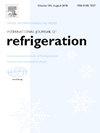Performance comparison investigation on different pulse tube position heat pumps with power recovery displacer
IF 3.5
2区 工程技术
Q1 ENGINEERING, MECHANICAL
International Journal of Refrigeration-revue Internationale Du Froid
Pub Date : 2025-04-18
DOI:10.1016/j.ijrefrig.2025.04.014
引用次数: 0
Abstract
Spacecraft waste heat is dissipated into space primarily by radiation. To improve the heat dissipation efficiency of spacecraft radiators in high-temperature environments and reduce heat wastage in spaceflight thermal control systems, thermoacoustic heat pumps (TAHP) are considered a viable method for increasing radiator cooling temperatures and recovering waste heat. In this study, one-dimensional simulations are used to optimize the geometrical parameters of the 100-watt work recovery thermoacoustic heat pump (WRTAHP) for various pulse tube positions. The performances of the two systems are compared at a cold-end temperature of 293 K and a hot-end temperature of 353 K. The results reveal that a heating capacity of 256 W with a relative Carnot efficiency of 35.01 % is achieved for the pulse tube front-type thermoacoustic heat pump (FTTAHP), whereas the pulse tube back-type thermoacoustic heat pump (BTTAHP) obtains a heating capacity of 225 W with a relative Carnot efficiency of 30.59 %. As the cold-end temperature decreases, the coefficient of performance is reduced for FTTAHP, while the performance of BTTAHP shows a substantial improvement. At a cold end temperature of 233 K and a hot-cold end temperature difference of 60 K, a heating capacity of 268 W with a relative Carnot efficiency of 50.57 % is achieved for BTTAHP. Furthermore, the heating capacity of the BTTAHP is not significantly increased by adopting the active phase adjustment structure. In summary, the FTTAHP is suitable for spacecraft radiator applications and avoids high temperatures affecting compressor operation, whereas the BTTAHP is better suited for low-temperature heating.
功率回收式不同脉冲管位置热泵性能比较研究
宇宙飞船的废热主要通过辐射散发到太空中。为了提高航天器散热器在高温环境下的散热效率,减少航天热控系统的热量浪费,热声热泵(TAHP)被认为是提高散热器冷却温度和回收余热的可行方法。在本研究中,采用一维模拟优化了100瓦工作回收热声热泵(WRTAHP)在不同脉冲管位置下的几何参数。比较了两种体系在冷端温度为293 K、热端温度为353 K时的性能。结果表明:脉冲管前置式热声热泵(FTTAHP)的供热能力为256 W,相对卡诺效率为35.01%;脉冲管后置式热声热泵(BTTAHP)的供热能力为225 W,相对卡诺效率为30.59%。随着冷端温度的降低,FTTAHP的性能系数降低,而BTTAHP的性能有较大的提高。在冷端温度为233 K,冷热端温差为60 K的条件下,BTTAHP的供热容量为268 W,相对卡诺效率为50.57%。此外,采用有源相位调整结构后,BTTAHP的供热能力没有明显提高。综上所述,FTTAHP适用于航天器散热器应用,避免高温影响压缩机运行,而BTTAHP更适合于低温加热。
本文章由计算机程序翻译,如有差异,请以英文原文为准。
求助全文
约1分钟内获得全文
求助全文
来源期刊
CiteScore
7.30
自引率
12.80%
发文量
363
审稿时长
3.7 months
期刊介绍:
The International Journal of Refrigeration is published for the International Institute of Refrigeration (IIR) by Elsevier. It is essential reading for all those wishing to keep abreast of research and industrial news in refrigeration, air conditioning and associated fields. This is particularly important in these times of rapid introduction of alternative refrigerants and the emergence of new technology. The journal has published special issues on alternative refrigerants and novel topics in the field of boiling, condensation, heat pumps, food refrigeration, carbon dioxide, ammonia, hydrocarbons, magnetic refrigeration at room temperature, sorptive cooling, phase change materials and slurries, ejector technology, compressors, and solar cooling.
As well as original research papers the International Journal of Refrigeration also includes review articles, papers presented at IIR conferences, short reports and letters describing preliminary results and experimental details, and letters to the Editor on recent areas of discussion and controversy. Other features include forthcoming events, conference reports and book reviews.
Papers are published in either English or French with the IIR news section in both languages.

 求助内容:
求助内容: 应助结果提醒方式:
应助结果提醒方式:


